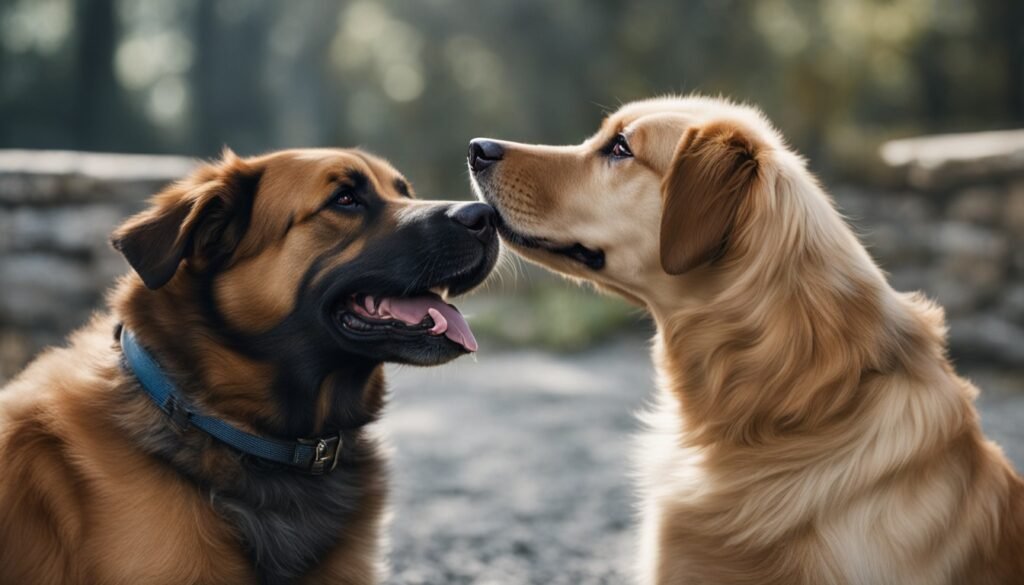You may be surprised to learn that certain dog breeds are significantly more likely to attack and be aggressive towards other dogs1. Bullmastiffs, Rat Terriers, and Terriers in general are noted for their high risk of aggression not only towards people but also other dogs1. On the other hand, Basset Hounds, Poodles, Maltese, and Japanese Chin are highlighted as having a low risk of aggression towards both people and other dogs1.
Key Takeaways
- Certain dog breeds, such as Bullmastiffs, Rat Terriers, and Terriers, are more prone to aggression towards other dogs.
- Basset Hounds, Poodles, Maltese, and Japanese Chin are considered peaceful breeds when it comes to interactions with other dogs.
- Small dog breeds like Jack Russell Terriers can be fickle and aggressive towards other dogs they don’t know.
- Large and giant dog breeds tend to exhibit assertiveness or combativeness towards other dogs, especially those of the same sex or smaller breeds.
- Responsible ownership and proper training are crucial in preventing aggressive behavior in dogs.
Dog Attack Statistics by Breed
When it comes to dog-on-dog attacks and aggression, certain breeds stand out2. Pit Bulls have been identified as the breed responsible for the most fatal attacks, accounting for 284 deaths in the United States between 2005 and 20172. In comparison, Rottweilers were involved in 45 fatal attacks, while German Shepherds and Huskies were responsible for 20 and 13 fatal incidents, respectively, during the same period2.
The data suggests that Pit Bulls are not only the breed that commits the most attacks overall but are also the most likely to be involved in a fatal attack. 23, According to the American Veterinary Medical Association, Pit Bulls were involved in over half of all reported dog bite incidents in the U.S. in 20233. This may be due to their breeding for aggression, their unwillingness to back down during fights, and their tendency to not give warning signs before biting2.
While certain breeds may be more prone to aggression, it’s important to note that individual temperament plays a significant role in a dog’s behavior3. Responsible pet ownership, proper training, and socialization are crucial in managing canine behavior and preventing dog-on-dog attacks. 34,
| Breed | Fatal Dog Attacks (2005-2017) |
|---|---|
| Pit Bulls | 284 |
| Rottweilers | 45 |
| German Shepherds | 20 |
| Huskies | 13 |
| Mixed Breeds | 17 |
| American Bulldogs | 15 |
| Mastiffs and Bullmastiffs | 14 |
| Labrador Retrievers | 9 |
| Boxers | 7 |
| Doberman Pinschers | 6 |
Which dog attacks other dogs the most?

When it comes to dog-on-dog aggression, certain breeds tend to be more prone to such behavior. Nearly all tiny breeds are fine with the pets in their own family but may be pugnacious toward other dogs they don’t know.5 In the small dog size category, terrier breeds like the Jack Russell Terrier are typically bold, pushy, and aggressive toward other dogs5. These dogs may display zero aggression one moment and 100% aggression the next, especially around food or toys.
Larger breeds such as pit bulls, German Shepherds, and Chow Chows also tend to be assertive with other dogs, which can progress to combativeness, especially toward dogs of the same sex or smaller dogs that trigger their prey instincts5. In fact, pit bulls are involved in 22.5% of all dog bite incidents5, and they were responsible for 66% of all dog bite-related deaths in the United States between 2005 and 20206. Other breeds like Rottweilers, German Shepherds, Doberman Pinschers, Chow Chows, Boxers, Siberian Huskies, Dalmatians, Alaskan Malamutes, and Great Danes have also been responsible for a significant number of fatal dog attacks each year6.
It’s important to note that the risk of dog-on-dog aggression can be mitigated through proper socialization, training, and responsible ownership. By understanding the temperament and behaviors of different breeds, pet owners can take proactive measures to prevent and address any aggressive tendencies, ensuring the safety of their furry companions and the community at large.
Large and Giant Dog Breeds’ Aggression Toward Other Dogs

When it comes to canine aggression, larger dog breeds can pose a significant risk, especially toward smaller dogs7. Most large and giant breeds are assertive with other dogs, which can progress to combativeness, particularly if the other dog is of the same sex or triggers their prey instincts7. Breeds like Akitas, Great Pyrenees, Cane Corsos, Rottweilers, and St. Bernards may view smaller dogs as potential prey, leading to aggressive behavior7. Caution is advised when introducing a large or giant breed dog to a home with an existing smaller dog.
The size and strength of these larger breeds can make them a formidable threat7. Studies suggest that being intact (not neutered) male dogs increases the likelihood of displaying aggression, further heightening the risk7. Additionally, genetics account for around 60-70% of observed differences in aggression between various dog breeds, with breeds such as German Shepherds, Doberman Pinschers, Rottweilers, and Pit Bull Terriers frequently cited as more aggressive due to their genetics and history7.
It’s important to note that no single cause of dog aggression exists; it stems from a combination of genetic, biological, environmental factors, health issues, and lack of socialization7. However, certain risk factors, such as body size and fearfulness, can increase the likelihood of aggressive behavior7. Small dog breeds are 2.5 times more likely to snap or bite family members compared to medium or large breeds, and dogs rated as highly fearful by their owners are over 5 times more likely to display aggression than non-fearful dogs7.
Responsible ownership, proper training, and socialization are crucial in managing the potential aggression of large and giant dog breeds toward other dogs7. By understanding the unique characteristics and risk factors of these breeds, pet owners can take proactive steps to ensure the safety of their canine companions and the community.
Conclusion
In summary, while any dog can potentially bite or display aggression, certain breeds have higher rates of attacks and fatal incidents compared to others8. Pit bulls, for instance, were responsible for 59% of fatal dog attacks in Utah from 2005 to 2020, and they were involved in 284 dog bite-related fatalities nationwide8. Other breeds like German Shepherds, Rottweilers, and some terrier breeds such as the Jack Russell Terrier have also been associated with higher levels of dog-on-dog aggression, often due to a combination of genetic predisposition and lack of proper socialization89.
Additionally, large and giant dog breeds can be assertive and combative with other dogs, especially those of the same sex or smaller size9. This is likely attributed to their size and perceived danger, as well as the role of sexual status in impacting aggression levels9. Responsible ownership, early socialization, and training are crucial in managing these tendencies and preventing potential attacks.
Understanding which breeds are most prone to dog-on-dog aggression can help owners take the necessary precautions to keep their pets and others safe10. Programs that require owners to take preventative measures, such as the one implemented in Multnomah County, have shown a significant reduction in repeat aggressive incidents10. By being aware of the risks and taking proactive steps, you can help foster a safer and more harmonious environment for all dogs and their owners.
FAQ
Which dog breeds are most likely to attack other dogs?
According to dog bite statistics, the breeds most involved in attacks on other dogs include pit bulls, mixed breeds, and German Shepherds. Pit bulls are responsible for 22.5% of all bite incidents, while mixed breeds account for 21.2% and German Shepherds 17.8%. Pit bulls are also the breed most likely to be involved in a fatal attack, representing 28% of dog bite-related deaths.
Why are pit bulls and other large/giant breeds more aggressive toward other dogs?
Pit bulls may present a greater danger due to being bred to be more aggressive, less likely to back down during fights, and less likely to give a warning before biting. Larger breeds like pit bulls, German Shepherds, and Chow Chows also tend to be more assertive with other dogs, which can progress to combativeness, especially toward dogs of the same sex or smaller dogs that trigger their prey instincts.
Are smaller dog breeds also prone to attacking other dogs?
While tiny dog breeds are usually fine with the pets in their own family, they may be pugnacious toward other dogs they don’t know, as a survival mechanism to try to prevent an attack by larger dogs. In the small dog size category, terrier breeds like the Jack Russell Terrier are typically bold, pushy, and aggressive toward other dogs. These dogs may display zero aggression one moment and 100% aggression the next, especially around food or toys.
How can owners prevent dog-on-dog attacks?
Understanding which breeds are most prone to dog-on-dog aggression can help owners take proper precautions to prevent attacks and keep their pets and others safe. This includes proper socialization, training for aggression, and caution when introducing a large or giant breed dog to a smaller dog. Owners should also be vigilant about managing their dog’s behavior around other animals.







